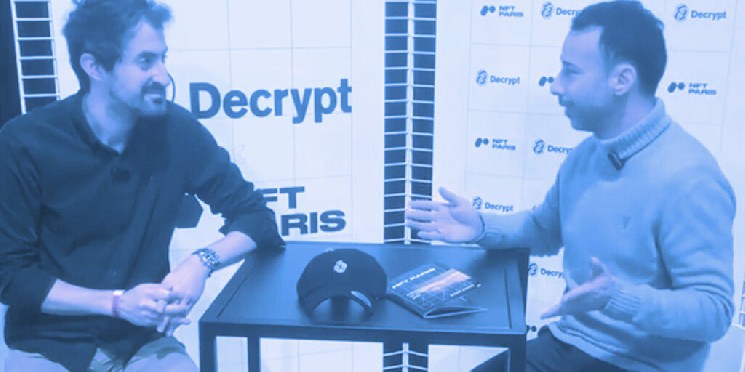Arianee’s Mission to Mint 10 Million NFTs With 50 Global Brands in 2023

“I don’t care about the bear market,” Arianee chief Pierre-Nicolas Hurstel proclaimed at NFT Paris last week in an interview with Decrypt.
Quickly clarifying that the dip is “not nice”, Hurstel—whose company has helped high-end brands like Yves Saint Laurent and Moncler issue NFTs—explained that the market lull means a real focus on practical use cases that will onboard more people into Web3.
“During the bull, we would get a telephone [call] every day from a brand that wants to make a million dollars with a stupid drop,” he said.
Nouns 3D-Printed Fashion Collection Turns Heads at NFT Paris
But now that the hype has cooled down, “the collections that are making money are real brands. They have a real product, they build a community around that, around creativity, collaboration,” said Hurstel.
And business is nevertheless booming for Arianee, in a way that Hurstel said hints at further mainstream adoption. “We minted 1 million NFTs last year, we’re going to mint probably 10 million NFTs this year, with more than 50 global brands,” he said. “This is going to touch my mum, your brother, your sister.»
Commenting on the unique position of France as a place to do Web3 business, he said it was not just new companies but established household names that will drive greater uptake of crypto and NFTs.
“We have a rich ecosystem of brands, brands that have deep relationships across the globe,” he said. “These brands are the brands that are going to take us from 100 million users to 1 billion users. It’s through concrete, pragmatic use cases that are going to interact with people in their daily lives that Web3 is going to become mainstream.”
Real-world use cases will begin to induct more people into Web3, because there will be a “good reason” for them to do so—be it digital proof of ownership or a multi-brand customer loyalty program.
Upon buying a sustainable product, for example, a digital product passport could prove the item’s credentials, as well as letting the owner prove it’s theirs.
“That is going to be 80% of our minting this year,” Hurstel said. “That is going to touch wine and spirits, appliances, luxury, fashion, it’s going to help build a circularity model around this industry.”
Web3 takes aim at loyalty points
He also predicted that interoperable loyalty programs will bring more people into the fold of Web3, with brands issuing tokens that customers can then use elsewhere. “Think about why you love your amex program, why I love my Amex program—it’s because the points I gain, I can transfer them to Airfrance or Delta. One-click.”
While the cost of a loyalty program might currently be prohibitive for smaller companies, Hurstel suggested that the openness of Web3 will allow more brands to make loyalty transferable.
“The weight and cost of a loyalty program for companies is super complicated to maintain. If all of a sudden, you benefit from a network effect thanks to the wallet and the tokens, then you have an open loyalty program for everyone, everywhere.”







 Bitcoin
Bitcoin  Ethereum
Ethereum  Tether
Tether  Dogecoin
Dogecoin  USDC
USDC  Cardano
Cardano  TRON
TRON  Chainlink
Chainlink  Stellar
Stellar  Hedera
Hedera  Bitcoin Cash
Bitcoin Cash  LEO Token
LEO Token  Litecoin
Litecoin  Cronos
Cronos  Ethereum Classic
Ethereum Classic  Monero
Monero  Dai
Dai  Algorand
Algorand  OKB
OKB  Cosmos Hub
Cosmos Hub  Stacks
Stacks  Gate
Gate  Theta Network
Theta Network  Tezos
Tezos  Maker
Maker  KuCoin
KuCoin  IOTA
IOTA  NEO
NEO  Polygon
Polygon  Zcash
Zcash  Tether Gold
Tether Gold  Synthetix Network
Synthetix Network  TrueUSD
TrueUSD  Dash
Dash  Holo
Holo  Zilliqa
Zilliqa  0x Protocol
0x Protocol  Enjin Coin
Enjin Coin  Basic Attention
Basic Attention  Qtum
Qtum  Siacoin
Siacoin  Ravencoin
Ravencoin  Hive
Hive  Bitcoin Gold
Bitcoin Gold  Decred
Decred  DigiByte
DigiByte  NEM
NEM  Ontology
Ontology  Huobi
Huobi  Nano
Nano  Waves
Waves  Status
Status  Lisk
Lisk  Steem
Steem  Numeraire
Numeraire  Pax Dollar
Pax Dollar  BUSD
BUSD  OMG Network
OMG Network  Ren
Ren  Bitcoin Diamond
Bitcoin Diamond